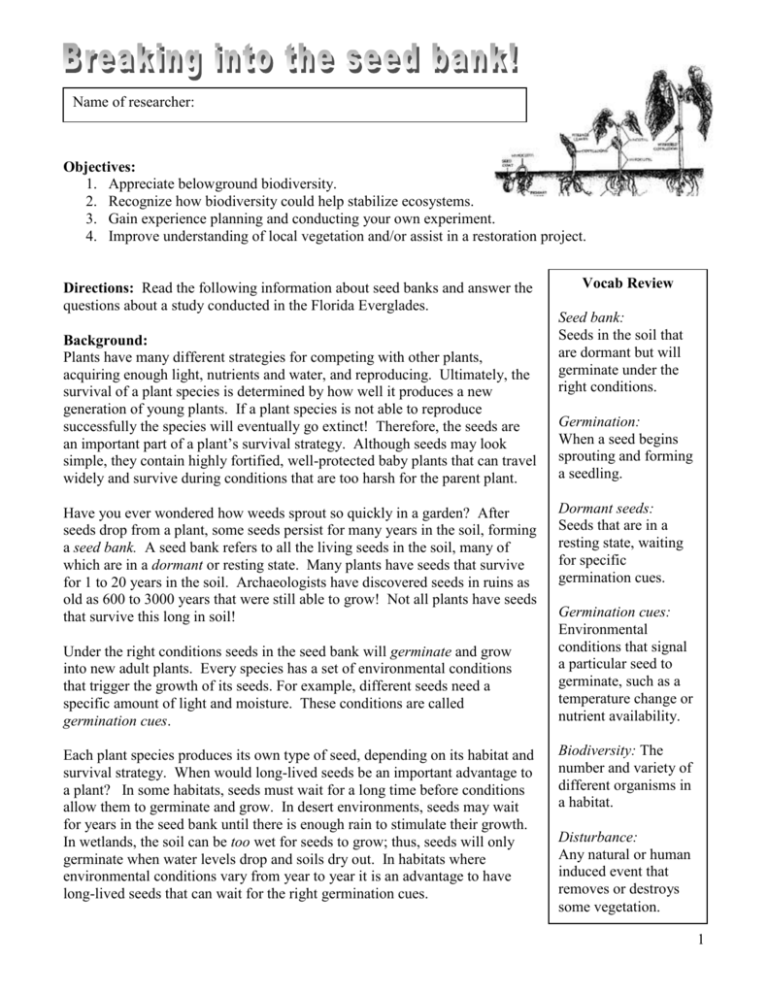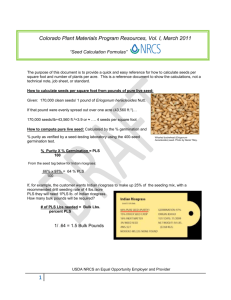Teacher`s Guide to the Student Reading
advertisement

Name of researcher: Objectives: 1. Appreciate belowground biodiversity. 2. Recognize how biodiversity could help stabilize ecosystems. 3. Gain experience planning and conducting your own experiment. 4. Improve understanding of local vegetation and/or assist in a restoration project. Directions: Read the following information about seed banks and answer the questions about a study conducted in the Florida Everglades. Background: Plants have many different strategies for competing with other plants, acquiring enough light, nutrients and water, and reproducing. Ultimately, the survival of a plant species is determined by how well it produces a new generation of young plants. If a plant species is not able to reproduce successfully the species will eventually go extinct! Therefore, the seeds are an important part of a plant’s survival strategy. Although seeds may look simple, they contain highly fortified, well-protected baby plants that can travel widely and survive during conditions that are too harsh for the parent plant. Have you ever wondered how weeds sprout so quickly in a garden? After seeds drop from a plant, some seeds persist for many years in the soil, forming a seed bank. A seed bank refers to all the living seeds in the soil, many of which are in a dormant or resting state. Many plants have seeds that survive for 1 to 20 years in the soil. Archaeologists have discovered seeds in ruins as old as 600 to 3000 years that were still able to grow! Not all plants have seeds that survive this long in soil! Under the right conditions seeds in the seed bank will germinate and grow into new adult plants. Every species has a set of environmental conditions that trigger the growth of its seeds. For example, different seeds need a specific amount of light and moisture. These conditions are called germination cues. Each plant species produces its own type of seed, depending on its habitat and survival strategy. When would long-lived seeds be an important advantage to a plant? In some habitats, seeds must wait for a long time before conditions allow them to germinate and grow. In desert environments, seeds may wait for years in the seed bank until there is enough rain to stimulate their growth. In wetlands, the soil can be too wet for seeds to grow; thus, seeds will only germinate when water levels drop and soils dry out. In habitats where environmental conditions vary from year to year it is an advantage to have long-lived seeds that can wait for the right germination cues. Vocab Review Seed bank: Seeds in the soil that are dormant but will germinate under the right conditions. Germination: When a seed begins sprouting and forming a seedling. Dormant seeds: Seeds that are in a resting state, waiting for specific germination cues. Germination cues: Environmental conditions that signal a particular seed to germinate, such as a temperature change or nutrient availability. Biodiversity: The number and variety of different organisms in a habitat. Disturbance: Any natural or human induced event that removes or destroys some vegetation. 1 Some environments experience frequent natural disturbances that destroy existing vegetation. For example, wildfires occasionally burn grasslands and savannahs, and extreme storms flood and damage some coastal wetlands. If these disturbances burn, kill or topple mature plants, more sun is able to reach the soil. Sunlight then triggers germination of seeds in the seed bank and these new seedlings can revegetate the recently disturbed area. A diversity of seeds in the seed bank ensures that as conditions change there are other species that are able to grow and replace the plants that die. Humans also create disturbances by plowing, logging or developing an area. When we clear land, more sun reaches the soil and seeds in the seed bank are able to germinate. Many of these new plants are considered weeds if they interfere with gardens or farm fields. Farmers may wish to prevent weeds in the seed bank from germinating. By understanding where seeds are hiding and what triggers their growth, we can better control undesirable plant species. After many years of cultivation, logging or development a habitat may lose its natural seed bank. What would happen if the seed bank was altered or degraded? An ecologist trying to restore a habitat might want to know if there are living seeds in the seed bank that could re-vegetate a degraded area. Think about the habitats in your area. What areas might have a larger or more diverse seed bank? Are there problems with weeds or undesirable plants? What triggers the growth of these “weedy” species? A Seed Bank Case Study: Restoring the Florida Everglades The Everglades is one of the largest wetlands in the United States. It is well known for its bird life and endangered species, such as the Florida panther. Unfortunately, agriculture and development have severely damaged this unique ecosystem. People have dammed Lake Okeechobee and built a canal at the outlet, preventing water from flowing through what used to be vast areas of wetlands. Scientists and politicians are attempting to restore this valuable ecosystem by returning the water to its natural flow path. Before they began re-routing the water to previously drained wetland areas, plant ecologists conducted a seed bank study to determine what sort of plants would naturally re-vegetate the newly flooded areas. Florida Panther in the Everglades National Park. Many species are dependent on the native wetland vegetation and natural water levels to survive. A group of researchers wanted to know how different water levels would affect the plants that were able to germinate. These scientists took soil samples from the area of the Everglades that was going to be restored and tried to germinate the seeds in the soil. They placed the soil under three different water treatments: (1) moist; (2) saturated; and (3) flooded with water above the soil surface. After two months they counted and identified all the seeds that germinated from these soils. Look at the graphs below and answer the questions. Think about how this seed bank study might guide restoration of the Everglades. Data is modified from Smith, S.M., P.V. McCormick, et al. 2002. Constraints of seed bank species composition and water depth for restoring vegetation in the Florida Everglades, USA. Restoration Ecology 10(1): 138-145. 2 Figure 1. Under which water level treatment were more seeds able to germinate? Figure 2. Which water level seems to promote the highest diversity of seeds germinating? (Diversity= number of species) Mean no. of plants Moist soils Average number of plants that germinated in each treatment 300 March 250 Sept 200 150 100 50 0 Moist Average number of species that germinated in each treatment Mean no. of species Saturated soils 7 6 5 4 3 2 1 0 March Sept Moist Conclusion: Smartweed produces seeds that waterfowl love, so wetland managers often try to encourage its growth. In contrast, cattail offers very little food for birds and it tends to aggressively expand, out-competing other plant species. If scientists what to foster a high diversity of plants and create a healthy habitat for water birds, how should they restore this area of the Everglades? Should they immediately flood the whole area, or gradually increase the amount of water so the soils are moist but not flooded? During restoration, they should keep the soils moist early in the season when seeds are germinating and then gradually increase the water depth so that wildlife can utilize the wetland. Flooded Average number of cattail plants that germinated in each treatment 6 No. of plants/m 2 Moist soils Saturated Figure 2. March 5 Sept 4 3 2 1 0 Moist Saturated Flooded Figure 3. Average number of smartweed plants that germinated in each treatment 20 No. of plants/m 2 Figure 4. What level of soil moisture allows smartweed to germinate most successfully? Flooded Figure 1. Moist soils Figure 3. What level of soil moisture seems to trigger the germination of cattail? Saturated March 15 Sept 10 5 0 Moist Saturated Flooded Figure 4. This material was developed through the Cornell Science Inquiry Partnership program (http://csip.cornell.edu), with support from the National Science Foundation’s Graduate Teaching Fellows in K-12 Education (GK-12) program (DGE # 0231913 and # 9979516) and Cornell University. Any opinions, findings, and conclusions or recommendations expressed in this material are those of the author(s) and do not necessarily reflect the views of the NSF. 3








